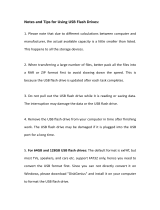
XE20/XE20SP Owner’s Manual
2
Table of Contents
Main Features .........................................................................3
Part Names
.............................................................................. 4
Front panel .................................................................................. 4
Rear panel
................................................................................... 4
Underside
.................................................................................... 4
Control panel
.............................................................................. 5
Display
......................................................................................... 6
Preparing to Play .................................................................... 7
Using the AC adapter ................................................................ 7
Turning the power on/o
.......................................................... 7
Adjusting the volume
................................................................ 7
Using music stand
...................................................................... 7
Using headphones
..................................................................... 7
Using a pedal
.............................................................................. 8
Preparing to Play: What is Auto-Accompaniment? ..............9
What is auto-accompaniment? ................................................. 9
Basic operations ...................................................................12
About modes ............................................................................ 12
Other functions
......................................................................... 12
Selecting sounds and changing values
.................................. 12
Playing the XE20 (style mode) ............................................. 13
Selecting a grand piano ........................................................... 13
Selecting sounds in the style set
............................................. 13
Muting parts and changing sounds
....................................... 13
Selecting a set list
..................................................................... 14
Changing the sounds on the left and right (split)
................ 14
Playing in time with the metronome
..................................... 15
Seing the key and octave
...................................................... 16
Adding eects and embellishments to your playing
.......... 16
Auto-accompaniment (style mode) ....................................18
Playing along with auto-accompaniment ............................. 18
Making changes to the auto-accompaniment
...................... 19
Choosing a music style and playing
...................................... 20
Saving the set list (WRITE)
..................................................... 21
Recording your performance
................................................. 21
Song mode ............................................................................22
Listening to the demo songs ................................................... 22
Playing along with a song
....................................................... 22
Playing back using dierent methods
................................... 22
Editing a song
........................................................................... 23
SETTING functions ................................................................25
Basic methods of use ................................................................ 25
Main SETTING functions
........................................................ 25
List of SETTING functions
...................................................... 26
MEDIA functions ................................................................... 28
Connecting and removing USB ash drives ........................ 28
Basic method of use
................................................................. 28
List of MEDIA functions
......................................................... 29
Connecting to an external device .......................................30
Connecting an audio player.................................................... 30
Connecting powered monitor speakers
................................ 30
Connecting to a computer
....................................................... 31
Appendix ............................................................................... 32
Checking the software version ............................................... 32
Restoring the XE20 to factory default seings
..................... 32
Calibrating an expression pedal
............................................. 32
Troubleshooting
....................................................................... 32
List of chords recognized
........................................................ 34
Specications ........................................................................ 35
MIDI Implementation Chart
.................................................36




















